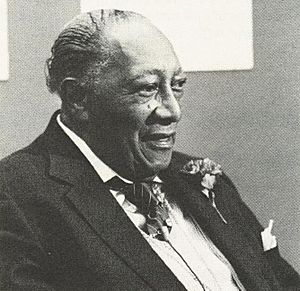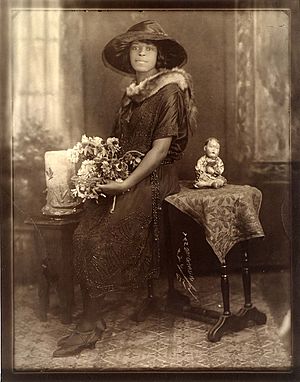James Van Der Zee facts for kids
Quick facts for kids
James Van Der Zee
|
|
|---|---|

Van Der Zee in 1981
|
|
| Born | June 29, 1886 Lenox, Massachusetts, U.S.
|
| Died | May 15, 1983 (aged 96) Washington, D.C., U.S.
|
| Known for | Portrait photography |
| Movement | Harlem Renaissance |
| Spouse(s) |
|
James Augustus Van Der Zee (born June 29, 1886 – died May 15, 1983) was an American photographer. He is famous for his amazing portraits of Black New Yorkers. Van Der Zee was a very important artist during the Harlem Renaissance. This was a time when Black art, music, and literature thrived in Harlem, New York City.
His photographs are not just beautiful art. They also show us a detailed look at life during that exciting time. He took pictures of many famous people, including Marcus Garvey and Bill "Bojangles" Robinson.
Contents
James Van Der Zee's Early Life
James Van Der Zee was born in Lenox, Massachusetts. From a young age, he showed a talent for music. He first dreamed of becoming a professional violinist.
But he also loved photography. As a teenager, he bought his first camera. He even made a darkroom in his parents' home. He took hundreds of photos of his family and his hometown. These pictures are some of the first records of community life in small-town New England.
Moving to Harlem
In 1906, James moved to Harlem in New York City. He worked as a waiter and an elevator operator. He was also a skilled pianist and a hopeful violinist. He helped create and perform in a group called the Harlem Orchestra.
In 1907, he married Kate L. Brown. They moved back to Lenox and had a daughter, Rachel. Later, they moved to Phoebus, Virginia. Their son, Emile, was born in 1908 but sadly passed away as a baby.
Starting His Photography Career
In 1915, Van Der Zee moved to Newark, New Jersey. He got a job in a photo studio. He started as a darkroom assistant. Soon, he became a skilled portrait photographer.
The next year, he returned to Harlem. Many Black people were moving to Harlem at this time. He opened a studio with his sister, Jennie Louise Van Der Zee. She was also known as Madame E Toussaint.
In 1916, Van Der Zee and Gaynella Greenlee opened the Guarantee Photo Studio. It was on West 125th Street in Harlem. They got married in 1918. His photography business grew very quickly during World War I.
His portraits from this time until 1945 are very famous. In 1919, he photographed the victory parade of the 369th Infantry Regiment. This was a mostly African American army unit. They were sometimes called the "Harlem Hellfighters."
In 1927, his daughter Rachel passed away at age 19. Van Der Zee photographed her funeral. He added poems and heavenly images to the final prints.
Capturing Harlem's Golden Age
During the 1920s and 1930s, Van Der Zee took hundreds of photos. He documented Harlem's growing middle class. People trusted him to capture their important moments. These included weddings, funerals, and social events. He also photographed celebrities and sports stars.
Van Der Zee quickly became the most successful photographer in Harlem. He photographed many famous people. These included poet Countee Cullen and dancer Bill "Bojangles" Robinson. He also photographed boxer Joe Louis and leader Marcus Garvey.
By the early 1930s, it became harder to earn money from photography. This was partly because of the Great Depression. Also, more people owned their own cameras.
Van Der Zee's Unique Style
Van Der Zee mostly worked in his studio. He used many props like special backgrounds and costumes. He created artistic scenes that looked like living pictures. People often copied famous poses from the 1920s and 1930s.
He also carefully retouched his photos. This means he changed them to make people look more glamorous. He wanted every picture to look better than the person. He once said, "I tried to see that every picture was better-looking than the person."
He also created special funeral photographs. These works were later put into a book called The Harlem Book of the Dead (1978).
In 1982, when he was 96, Van Der Zee photographed a young painter. His name was Jean-Michel Basquiat. This photo was for Interview magazine.
James Van Der Zee passed away in Washington, D.C., on May 15, 1983. A year later, he was added to the International Photography Hall of Fame and Museum.
Important Photography Projects
Documenting the UNIA
In 1924, Van Der Zee worked on a special project. He photographed members and activities of Marcus Garvey's Universal Negro Improvement Association (UNIA). He took thousands of photos for this assignment. Some were even used in a calendar for members in 1925.
Harlem on My Mind Exhibition
In 1969, Van Der Zee became famous worldwide. His work was shown in a big exhibition. It was called Harlem on My Mind. This show was at the Metropolitan Museum of Art in New York.
A researcher for the exhibition found Van Der Zee's studio. He asked if Van Der Zee had any photos from the 1920s and 30s. Van Der Zee showed him many boxes of old photo negatives. These photos became the main part of the Harlem on My Mind show. Critics loved them.
Art historian Sharon Patton said that Van Der Zee did more than just document the Harlem Renaissance. He also helped create it.
Exhibitions of His Work
Solo Exhibitions
- 1970: Lenox Library, Massachusetts
- 1971: Studio Museum in Harlem, New York
- 1974: Lunn Gallery/Graphics International, Washington, D.C.
- 1979: The Legacy of James Van Der Zee: A Portrait of Black Americans, New York and Delaware
- 1983: Camera Club of New York and Idaho State University
- 1987: Deborah Sharp Gallery, New York
- 1994: Retrospective, National Portrait Gallery Washington, D.C. and Howard Greenberg Gallery, New York
Group Exhibitions
- 1969: Harlem on My Mind, Metropolitan Museum of Art, New York
- 1978: Lunn Gallery, Washington, D.C.
- 1979: San Francisco Museum of Modern Art and Fleeting Gestures: Dance Photographs, New York
- 1982: Rheinisches Landesmuseum, Bonn, Germany
- 1985: San Francisco Museum of Modern Art
- 1987: Studio Museum in Harlem, New York



